Abstract
This paper investigates the potential utilization of the Tunnel Boring Machine (TBM) muck generated from Doha’s Metro Gold Line in different construction applications. The properties of the raw TBM muck were studied, and the results were compared to the specifications of Qatari Construction Standards (QCS 2014) of concrete aggregates, fill material under buildings and road subgrades. Compared to the requirements of concrete aggregates, the results indicated that the gradation of the raw TBM muck does not comply with the QCS 2014 requirements, and hence, sieving and screening may be essential. Moreover, the tests’ results showed that the properties of the muck meet the requirements of the concrete coarse aggregates, except for the water absorption, loss by magnesium sulphate soundness, loss by Los Angeles abrasion and the acid-soluble sulphate. As fill material under buildings or road subgrades, the gradation of the TBM muck complies with the QCS 2014 requirements, while the liquid limit and plasticity index are higher than the QCS 2014 permissible limits. Additionally, the morphological structure and the elemental composition of the raw TBM muck were determined by employing Scanning Electron Microscopy (SEM) and Energy Dispersive X-ray analysis (EDX), respectively. Digital images were also taken at larger scale to draw a full picture of the TBM muck morphology. A mixture of rough-rounded to angular-elongated shaped particles with relatively large voids could be observed. The EDX analysis demonstrated the presence of silicon (Si) as the predominant component of the muck, which may alter the Coefficient of Thermal Expansion (CTE) values for mixtures prepared using TBM muck. Hence, further investigations should be performed on the mechanical and thermal properties of mixtures containing TBM muck as aggregates’ replacement, and further work should be directed toward this end.
Keywords:
TBM muck; physical; chemical and mechanical tests; EDX; recycling; construction; sustainability; aggregates 1. Introduction
The world is witnessing an unexpected population growth and urbanization and, hence, there is an increasing demand for new and efficient infrastructure systems. In order to adapt to such trends, many construction activities are already taking place in different countries such as building underground highway networks and rail tunnels. Conventionally, drill and blast methods were used for tunneling. However, Tunnel Boring Machines (TBMs) have been used over the last 20 years in many countries to excavate tunnels in hard rock [1,2,3,4]. This technology leap has shown a leverage exceeding the conventional methods. TBM provides a gentle tunneling with smooth cross-sections and at the same time avoids any existing underground construction. It also overcomes the depth and underground flow limitations that were experienced earlier. The resulting TBM muck is much finer and has a flaky-shape material that could potentially be used as an alternative to rock aggregates or sand [5].
Several million tons of muck are generated each year by TBMs. This excavated rock material is mostly competent and strong. However, it is normally treated as a waste, ending up in landfills or stockpiled as deposits with no beneficial use [6,7]. The extensive transport of muck for long distances may be required throughout the project, which results in the emission of polluting gases. Treatment and disposal are also required sometimes for such TBM spoil, which increase the cost of the project. Accordingly, researchers started to investigate the potential use of TBM muck as a construction material for roads, parking lots and buildings. Utilizing TBM muck as concrete aggregates, roadway fill and subgrade and/or backfilling under structures would be more beneficial economically and environmentally compared to landfilling [8,9,10,11,12,13].
To be utilized as a construction material, TBM muck must meet certain physical and chemical properties and have economic benefits for using it in lieu of disposal. Relatively few research studies have been conducted or published on the use of TBM muck in construction applications. Such studies have concluded that TBM muck could be utilized in many construction and specialty applications and could be increasingly used as an aggregate substitute in the future with minimum processing [8,14]. Gertsch et al. [10] investigated the stability of muck produced by a laboratory TBM operating in a welded tuff in different construction applications. They have described various tunneling projects that have utilized, or tried to utilize, TBM muck in construction purposes. They concluded that TBM muck from hard rock is a well-graded material containing flaky chips with little fines, and hence, it could be used successfully for many purposes with a little modification (if needed) by conventional aggregate-processing methods. Grünner et al. [11] described a method for the evaluation of muck extracted from the pilot gallery of the Mismove tunnel (northern Slovakia). This method included different laboratory tests such as short frost resistance and adsorption tests. Although they could not demonstrate a definitive conclusion on the use of muck in construction applications, they indicated that in order to make the decision on the possibilities of utilizing the muck as a construction material, it should be evaluated separately each time depending on the driving method and the geology of the area from which it has been extracted. In 2011, Bellopede and Marini [7] investigated the effects of different treatments on rock excavated using TBM or traditional drill and blast excavation methods. They conducted laboratory tests on raw muck as well as muck treated in mobile and fixed plants. They reported that raw TBM muck is not suitable as concrete aggregates due to its flaky-shape particles. However, they observed that the treatment of TBM muck in a fixed plant using a two-hammer crusher and a secondary jaw crusher could reduce the flakiness index and, hence, make the muck comply with the concrete aggregate requirements.
In 2018, Berdal et al. [13] presented their research results on the potential use of raw TBM muck obtained from European TBM projects as concrete aggregates. They also showed test results on TBM muck extracted from two more recent Norwegian projects. By studying the Particle Size Distribution (PSD) of TBM muck from different sites and by measuring the effect of PSD of fine particles on the flow of fresh cement paste, they concluded that the utilization of raw TBM muck from eight different European projects varied from 0% to 100%. They also showed that the TBM fines (0–0.125 microns) from the two Norwegian projects had a very similar effect as natural limestone filler on the flow of the fresh cement paste.
Generally, TBM muck may have a limited usage in worldwide construction applications as there are no universal specific standards, which permit/control the use of this material in road and building construction. This is because sustainability of TBM muck is not yet well demonstrated. The properties of TBM muck are highly dependent on the geology of the area from which it has been extracted as well as the TBM technology used for excavation (cutter size, chemicals used, etc.). Hence, the excavated material from each TBM project should be studied separately to determine its suitability as a construction material and to decide on the processing requirements. If only raw TBM spoil is used, it may result in a water demanding concrete and the potential loss of mechanical properties due to the flaky-shape particles and the presence of impurities [5].
One of the breakthroughs in TBM tunneling is Doha’s Metro project. Under the capital of Qatar, a 111 km of brand-new and extra-modern metro tunnels have been created in just over two years using TBMs managed by Qatar Rail Company. The construction of such a huge tunneling system could be considered to be one action taken for the preparation of the country to host the FIFA World Cup in 2022 and to achieve the vision of connecting every part of the country by an efficient public transport system. The rapid construction of Doha’s Metro project with the highest standards of safety and quality made it gain an entry to the Guinness Book of Records [3]. The construction of Doha’s metro tunnels has been divided into two phases. Phase-1, which was fully operational in 2020, consists of three main lines namely, Red Line, Green Line and Gold Line. Phase-2 of the project consists of the excavation and construction of the Blue Line, which is expected to be operational in 2026. It should be noted that the routes for all the metro lines runs under congested and highly populated areas as well as under tourist centers and health facilities. A settlement-free tunneling was consequently required during construction. Twenty-one TBMs were designed and operated to tunnel their way forward and to achieve the successful construction of this mega project.
As per the information provided by Qatar Rail Company, the TBM muck generated from Phase-1 tunnel lines was piled at four different logistical areas in Doha with an approximate total quantity of five million tons. Those areas were designated as MLPA South, MLPA West, MLPA North and MLPA Al-Rifaa. It should be emphasized that the properties of TBM muck is highly dependent on the geological properties of the tunneled area as well as the chemicals that are used in the TBMs to facilitate the excavation process. Accordingly, the properties of TBM muck generated from Doha’s Metro project should be evaluated for every route separately in order to investigate the variations in the properties, if any. In order to have accurate information and quantitative data on the muck generated from Doha’s Metro project and to guarantee an access to the different logistical areas to collect muck samples, collaboration was established with Qatar Rail Company to carry out this research study.
This paper presents the results obtained on the characterization and identification of the potential construction application of TBM muck generated from Doha’s Metro Gold Line and piled at MLPA Al-Riffa. Physical, chemical and mechanical tests were conducted on the raw TBM material, and the results were compared to the specifications limits of the Qatari national standards (QCS 2014) for different construction applications. This research will launch the start of development of draft clauses to formalize and permit the use of recycled TBM muck as a material for road and building construction. Using TBM muck as an alternative local aggregate in any county provides considerable cost savings by decreasing the costs associated with importing aggregates from other countries and other costs associated with late material delivery and disposal.
2. Muck Sampling and Collection
The required information and quantitative data on the muck generated in Qatar were provided by Qatar Rail Company. Qatar Rail staff made all arrangements and granted access for the research team to collect samples of TBM muck from the site. As the TBM properties may vary depending on the location where they were extracted from, this study was limited to the TBM muck generated from Doha’s Metro Gold Line and piled at MLPA Al-Riffa site (Figure 1).
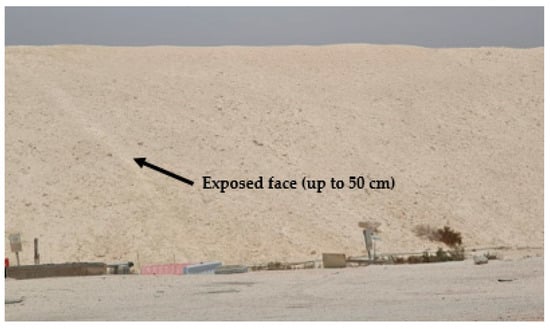
Figure 1.
Gold Line TBM muck piled at MLPA Al-Riffa area.
The Gold Line (also called the Historic Line) links Qatar’s industrial area in the north with the Doha international airport. The geology of the area through which the Gold Line runs could be considered consistent. In order to obtain an exact picture of the geological properties, an adequate number of boreholes with depths up to 70 m was drilled and investigated in the whole project area. It was found that the soil strata comprise fill material (or man-made soil with minor thickness), Simsima Limestone, Midra Shale and Rus Formation. The tunnels are completely located in the Simsima Limestone. This layer consists of crystalline limestone and contains dolomite rock and with a number of cavities and irregular fissures filled with soft siltstone. However, no joints or parallel discontinuities were encountered within this layer, and hence, it is considered homogeneous and isotropic in terms of its strength and deformability. The subsequent Midra Shale layer is encountered beneath the tunnel structure. It consists of crystalline limestones and siltstones with pronounced discontinuities and steeply inclined joints. Accordingly, this layer could be considered heterogeneous, and hence, the anisotropic behavior of the rock mass model should be assumed. The Rus Formation, encountered below Midra Shale, comprises dolomite limestone with various extensive layers of saline residues, mainly consisting of gypsum [15].
Planning and formulating all aspects of TBM muck sampling and obtaining representative samples were carried out according to ASTM D4687 [16] and ASTM D6009 [17] standards. Such standards state that sampling scheme/strategy and frequency (number of samples) for a waste pile should be based on several factors, including the study objectives, properties of wastes in the pile, degree of confidence required, access to sampling points, and budgetary constraints.
Because of the site and financial constraints and because the research’s main goal is merely to establish whether the muck meets some certain criteria, a judgment sampling scheme was employed in this study as recommended by ASTM D4687 standards [16]. Such a sampling scheme or strategy normally calls for collecting a composite of surface samples and samples taken from a specified depth. The composite sample is a well-mixed blend of those subsamples taken from different points, and locations are normally decided by visual observations and the collector’s judgment. Such a sample could be considered a representative sample that reflects the whole composition of the TBM muck in a cost and resource efficient way, and it is commonly effective in determining an average measure of a parameter [16,17].
As per the information provided by Qatar Rail Company, 576,926 m3 of TBM muck were generated from Doha’s Metro Gold Line and piled in the MLPA Al-Riffa area, as shown in Figure 1. Fifteen tons of TBM muck were collected by taking 10 random samples of the same size (about 1.5 tons) from five different locations at the muck pile surface, and another five locations deeper than 50 cm below the surface of the muck pile. Samples from the surface were directly collected using a wheel loader. Other samples were collected by removing about 50 cm of the muck pile face and moving it to another site location using a front-end loader bucket to expose the inaccessible inner portions of the muck at approximately equal increments. The discrete samples were then loaded to a single truck for mixing in order to form a homogeneous representative sample.
After collecting the required muck representative samples, they were transported to the laboratory site and stored in a closed room. Characterization tests were conducted as per the following sections, depending on the application where TBM muck would be used.
3. Experimental Tasks, Methods and Materials
This study included three experimental tasks as follows:
Task I: Characterization of TBM muck.
Task II: Screening and sieving of TBM muck.
Task III: Comparison of tests results with Qatar’s Construction Specifications (QCS 2014) [18] for aggregates utilized as:
- Partial or full replacement of concrete aggregates.
- Fill material (earthworks) under buildings.
- Road fill and subgrade material.
3.1. Task I: Characterization of TBM Muck Generated from Doha’s Metro Gold Line
In this task, a random portion was taken from the collected representative muck sample, and the Particle Size Distribution (PSD) was determined using the BS EN 933-1 sieving method. Moreover, the morphological and crystalline structures of raw TBM muck were determined by employing Scanning Electron Microscopy (SEM). In addition, the Energy Dispersive X-ray analysis (EDX) was used to identify the mineralogy of the muck. The data generated by EDX analysis consist of spectra showing peaks corresponding to the elements making up the true composition of the TBM sample. As mentioned earlier, the composition of TBM may vary depending on the location from where it was extracted, the TBM features and the chemicals that could be used to facilitate the excavation process.
Three random samples of raw TBM were analyzed using SEM and EDX. All samples were dried using vacuum and later coated using gold palladium to dissipate excess charges and to enhance image resolution. A low-energy Secondary Electron (SE) and Backscattered Electron (BSE) imaging options were used to capture SEM images at 50 and 5 μm scales.
3.2. Task II: Screening and Sieving of TBM Muck
In addition to the eyesight observations, the PSD determined in Task 1 demonstrated that the raw TBM grading showed a large variation in the size of the muck. The particles’ sizes varied from large particles (more than 75 mm) to very fine particles (passing sieve size 0.063 mm). Hence, before doing any testing on the TBM sample, it was subjected to screening and sieving at a local ready-mix plant in order to have aggregates with a particle size distribution that closely matched the standard requirements of the aggregates used in different construction applications.
3.3. Task III: Comparison of Tests Results with Qatar’s Construction Specifications (QCS 2014)
After the screening and sieving performed in Task II, TBM muck samples were classified into coarse aggregates (10–20 and 4–10 mm), fine aggregates (0.063–4 mm) and particles with size less than 0.063 mm (dust). The potential utilization of TBM muck extracted from Doha Metro Gold Line was investigated by initially determining its physical, chemical and mechanical properties. Test results were then compared to the specifications limits established in QCS 2014.
3.3.1. TBM Muck as a Partial or Full Replacement for Concrete Coarse Aggregates
Qatar Construction Specifications (QCS 2014, Section 5, Part 02) [18] and international standards specify the properties of the construction materials that are acceptable as coarse aggregates in normal concrete. The research team conducted the following tests on three samples of the TBM muck (size 10–20 mm) and similar tests on three samples of size 4–10 mm. The average values of the following results were considered and compared to the specification limits: particle density (BSEN 1097-6) [19], water absorption (BSEN 1097-6) [19], clay lumps and friable particle (ASTM C142) [20], shell content (BSEN 933-7) [21], flakiness index (BSEN 933-3) [22], aggregate drying shrinkage (BSEN 1367-4) [23], loss by magnesium sulphate soundness (BSEN 1367-2) [24], loss by Los Angeles abrasion (BSEN 1097-2) [25], acid-soluble chloride (BSEN 1744-5) [26], acid-soluble sulphate (BSEN 1744-1) [27], and lightweight particles(ASTM C123) [28].
3.3.2. TBM Muck as Fill Material (Earthworks) under Buildings
Section 12, Part 03 of Qatar Construction Specifications (QCS 2014) [18] describes the acceptable materials for use in earthworks and as a fill material under buildings. To be accepted as a fill material under buildings, TBM muck should meet the requirements of the following tests: rock particles exceeding 75 mm (ASTM D6913) [29], material passing 0.075 sieve (ASTM D1140) [30], liquid limit (BSEN 1377-2) [31], plasticity index (BSEN 1377-2) [31], organic matter content (BSEN 1377-3) [32], water-soluble chloride (BSEN 1377-3) [32], water-soluble sulphate (BSEN 1377-3) [32], acid-soluble chloride (BSEN 1377-3) [32] and acid-soluble sulphate (BSEN 1377-3) [32]. Three random muck samples were subjected to the aforementioned tests, and the average values were compared to the specifications limits.
3.3.3. TBM Muck as Road Fill and Subgrade Material
Materials used for subgrades and/or fill below the formation level of the roadways should meet the requirements of Section 06, Part 03 of QCS 2014 [18]. Such requirements include the percent passing the 75 mm sieve (ASTM D6913) [29], the percent passing the 0.075 mm sieve (ASTM D1140) [30], liquid limit (ASTM D4318, Method A) [33], plasticity index (ASTM D4318) [33], organic matter content (BS EN 1377-3) [32], acid-soluble chloride (BS EN 1377-3) [32] and acid-soluble sulphate (BS EN 1377-3) [32], California Bearing Ratio, CBR (ASTM D1883, soaked condition) [34], and swelling (ASTM D1883, soaked condition) [34]. All tests were performed on three random muck samples, and the average values were compared to the specification’s limits.
4. Results and Discussion
4.1. Particle Size Analysis, PSD (Gradation)
Table 1 shows the PSD of the TBM muck when considered for use as concrete aggregates. The test was performed in accordance with BS EN 933-1 [35]. It should be noted that the QCS 2014 specifications of concrete aggregates refers to the PD 6682-1 as a standard of aggregate grading [36]. The graphical presentation of PSD results is shown in Figure 2, where the cumulative percent passing results were compared to the PD 6682-1 [36] gradation limits. The gradation curve showed that raw TBM muck does not comply with the standard requirements for concrete aggregates. Hence, screening and sieving is needed before any attempt to utilize the muck in concrete mixtures as an aggregate replacement.

Table 1.
Particle Size Distribution (PSD) of muck when considered for use as concrete aggregates.
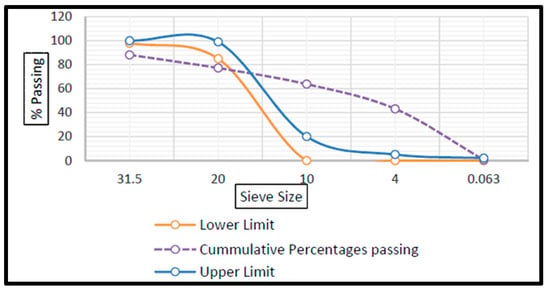
Figure 2.
Particle size distribution of TBM muck and PD 6682-1 gradation requirements for concrete aggregates.
However, Table 2 shows that TBM muck gradation obtained according to ASTM D6913 [29] and ASTM D1140 [30] complies with the QCS 2014 gradation requirements for fill materials under buildings or as road fill.

Table 2.
Particle size distribution (PSD) of TBM muck as building or /road fill material according to ASTM D6913 and ASTM D1140.
4.2. Screening and Sieving of TBM Muck
As indicated in Section 4.1, TBM muck gradation does not comply with the specification’s requirements for concrete coarse aggregates. Thus, prior to using TBM muck in concrete mixtures, it should be initially classified based on a sieve analysis in order to have aggregates with acceptable sizes (10–20 mm (Figure 3a and 4–10 mm (Figure 3b). Using the appropriate sieves, the muck particles were classified into five categories:
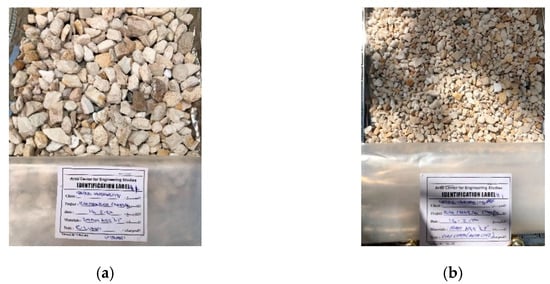
Figure 3.
(a) Particles size from 10 to 20 mm, (b) Particles size from 4 to 10 mm.
- Particles size from 20 to 75 mm.
- Particles size from 10 to 20 mm
- Particles size from 4 to 10 mm
- Particles size from 0.063 to 4 mm.
- Particles size less than 0.063 mm.
This classification will be considered a pre-step for future work where TBM muck is used as partial or full replacement of concrete coarse aggregates.
4.3. Scanning Electron Microscopy (SEM) and Energy Dispersive X-ray (EDX) Analysis
Three samples of TBM were analyzed using SEM (at different scales) as shown in Figure 4, Figure 5 and Figure 6. The SEM images were taken at 50, 30, 10 and 5 μm scales in order to fully understand the muck morphology (surface texture, shape, surface pores, etc.). Moreover, digital images at larger scales were taken to observe the morphology of the larger particles as shown in Figure 7. The EDX analyses of each sample corresponding to the SEM images are shown in Figure 8, Figure 9 and Figure 10, respectively.
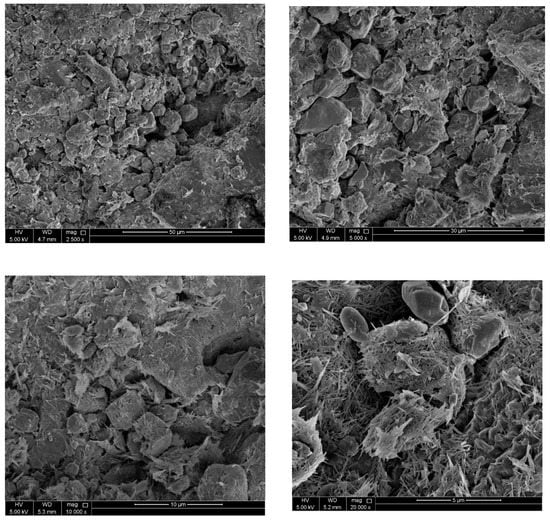
Figure 4.
SEM images of TBM muck Sample #1 at different scales.
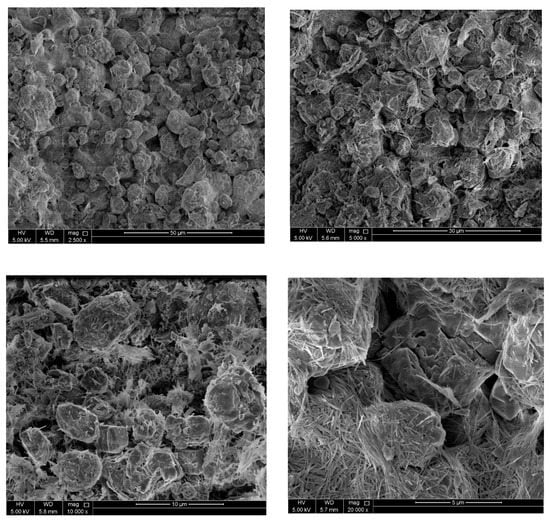
Figure 5.
SEM images of TBM muck Sample #2 at different scales.
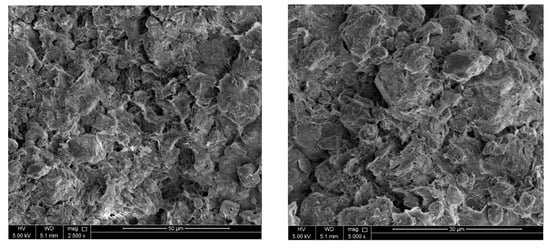
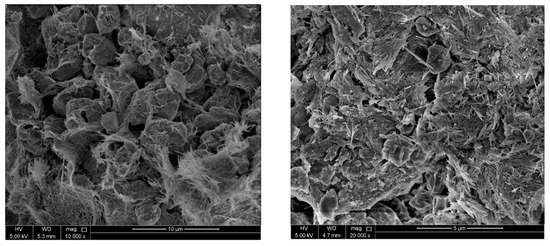
Figure 6.
SEM images of TBM muck Sample #3 at different scales.

Figure 7.
Digital images of TBM muck samples retained on each sieve during sieve analysis.

Figure 8.
EDX analysis of TBM muck Sample #1.

Figure 9.
EDX analysis of TBM muck Sample #2.

Figure 10.
EDX analysis of TBM muck Sample #3.
The SEM images shown in Figure 4, Figure 5 and Figure 6 may reflect the morphological characteristics of the TBM muck particles. It could be noted in the SEM images that the particles with clear irregular contours in the SEM images do not exceed a maximum of 50 µm; however, the gradation results presented in Table 1 show that 99.4% of the particles are larger than 63 µm. Digital images at a larger scale were taken for each portion of the muck sample retained on each sieve during the gradation process in order to observe the morphological properties of the larger particles, as shown in Figure 7. It can be seen in Figure 7 that the TBM muck particles could be considered a mixture of rounded to angular and elongated shaped particles. This might affect the workability of the concrete mixture when the muck is utilized as a coarse aggregate replacement. However, this issue could be overcome by incorporating chemical superplasticizers to enhance the workability of the concrete mixture. Moreover, it was observed that the TBM muck has a relatively large number of voids, which explains the high-water absorption value of the muck (which is presented in the following sections). However, the high-water demand of the mixture containing TBM muck could be tackled by using high-range water reducers (HRWRs). By decreasing the SEM images scales to 10 and 5 μm, it could be clearly noted that the muck particles have a rough surface texture which may enhance the mechanical bond with cement paste in concrete mixtures, especially in high-strength concrete, as reported by Al-Oraimi et al. [37]. Other researchers also suggested that, in high-strength concrete, the bond strength between the cement and aggregates is a limiting factor for the overall mixture strength rather than the strength of the aggregate itself [38,39]. This suggests that that the use of TBM muck in high-strength concrete may result in a significant improvement of the mechanical properties of the mix due to the rough surface texture of the muck particles. This conclusion should be demonstrated by further testing of concrete mixtures prepared using TBM muck as a partial or full aggregate replacement.
In correspondence with the muck examination using SEM, its elemental composition was determined by EDX. As shown in Figure 8, Figure 9 and Figure 10, the major components of the TBM muck are oxygen (O), carbon (C), magnesium (Mg), silicon (Si) and calcium (Ca).
An et al. [40] investigated the chemical composition of different coarse and fine aggregates and studied the effect of that composition on the Coefficient of Thermal Expansion (CTE) of concrete mixture. They reported that the silicon contents in dolomite, granite, manufactured sand and natural sand were 0.12%, 18.59%, 11.49% and 14.54% by weight of the aggregates, respectively. The authors demonstrated that the CTE increases with the increase in the aggregates’ silicon content. They also found that concrete mixtures with higher CTE are expected to be more susceptible to thermal stresses, which may result in lowering the compressive strength [40]. The EDX analyses of the TBM muck presented in Figure 8, Figure 9 and Figure 10 show that the Si content does not exceed 7% by weight of the muck. This suggests that the concrete mixtures with TBM muck may exhibit different thermal properties. Hence, further testing on actual concrete mixtures containing TBM muck should be directed toward investigating the thermal properties, specifically.
4.4. TBM Muck as a Partial or Full Replacement of Concrete Coarse Aggregates
Three random muck samples were subjected to the tests mentioned in Section 3.3.1. Table 3 presents the average results obtained from each test.

Table 3.
Comparison between the properties of TBM muck and QCS 2014 (specifications of concrete coarse aggregates).
Table 3 indicates that the raw TBM muck extracted from the Gold Line meets the requirements the coarse aggregates, except for the water absorption, loss by Magnesium sulphate soundness, loss by Los Angeles abrasion and the acid-soluble sulphate. However, the effect of these properties on the overall behavior of concrete mixtures should be investigated by replacing different percentages of concrete aggregates with TBM muck and studying the effect of such replacement on the fresh and hardened properties of concrete. This will be part of the future work that will commence as part of this research project.
4.5. TBM Muck as a Fill Material (Earthworks) under Buildings
Table 4 presents the average test results obtained on three samples of TBM muck when considered to be used as a fill material for earthwork under buildings.

Table 4.
Comparison between the properties of TBM muck and QCS 2014 (specifications of suitable filling material related to buildings).
Table 4 indicates that the raw TBM muck has liquid limit and plasticity index values that are higher than the permissible limits of QCS 2014 for a fill material under buildings. This may be a limitation for using the TBM muck in such a construction application. However, future additional work could be directed toward the improvement of TBM muck through stabilization with Portland cement or fly ash or via blending it with other acceptable soils or aggregates such as gabbro.
4.6. TBM Muck as a Road Fill or Subgrade Material
Table 5 shows the average test results on three TBM muck samples when considered to be used as a road fill or subgrade material.

Table 5.
Comparison between the properties of TBM muck and QCS 2014 (specifications of suitable road filling and subgrade materials).
Table 5 indicates that the liquid limit and plasticity index results for TBM muck do not meet the requirements of QCS 2014 standards. However, gradation, organic matter content, acid-soluble chloride and sulphate, CBR and swelling values were satisfactory. As suggested earlier, the raw TBM muck could be modified by stabilization or blending with other high-quality soils or aggregates to meet the specifications requirements. Future research works could be directed toward this end.
It is worth noting that TBM muck could be also utilized in road sub-bases and bases according to QCS 2014, Section 6, Part 9. In order to consider this application, the sand equivalent value should be determined and compared to the QCS 2014 requirement of a minimum of 25%. In addition, the CBR value should meet a minimum requirement of 80% for unbound materials as specified in QCS 2014. Thus, it is important to emphasize that additional work should focus on the improvement of TBM muck through stabilization with Portland cement and fly ash or via blending with other high-quality soils or aggregates. The most cost-feasible stabilizers are cement, lime, fly ash, and bitumen (usually in the form of asphalt). Lime is best suited for fine materials such as clays. Portland cement is commonly used to improve the performance of low-quality or marginal aggregates. The amount of cement needed to achieve stabilization varies from 3.5% to 7%, by weight for granular materials, and from 7% to 10%, by weight for silts and clays. Steel slag, which is commonly abundant in Qatar, could be also considered for blending with the TBM muck.
5. Conclusions
This paper presents the results of an investigation into the potential utilization of TBM muck generated from Doha’s Metro Gold Line in different construction applications such as concrete coarse aggregates, fill material under buildings and road fill/subgrade. Physical, chemical and mechanical tests were conducted on the raw TBM material, and the results were compared to the acceptable specifications limits of QCS 2014. This research could launch the start of development of draft clauses to formalize and permit the use of TBM muck as a constituent material in construction. Significant cost savings would be realized if such muck could be used as a local aggregate alternative in lieu of importing aggregates from other countries. The following conclusions are warranted at this time:
- The gradation of the raw TBM muck does not comply with the QCS 2014 standard gradation requirements for concrete aggregates. Hence, screening and sieving are needed before any attempt to use the muck as aggregate replacement in concrete. However, the TBM muck gradation complies with the QCS 2014 requirements for fill materials under buildings and road fills and subgrades.
- The SEM images of the raw TBM muck showed that the particles with clear irregular contours do not exceed a maximum of 50 µm; however, the gradation results showed that almost all of the particles are larger than 63 µm. Hence, digital images at larger scale were taken in order to observe the overall morphological properties of the muck. Such images showed mixtures of rounded to angular and elongated shaped particles.
- It could be also noted from the SEM images that the muck particles have a relatively large number of voids, and hence, high water absorption values were determined. It could be also observed that the muck surface texture is rough, which may lead to a better bond with cement paste in concrete mixtures. Further testing of concrete mixtures containing TBM muck as a partial or full aggregate replacement is essential to investigate such behavior.
- According to the EDX analysis, the silicon (Si) is a dominant component of the TBM muck and its content differs from the silicon content in other coarse and fine aggregates (sand) as reported in the literature. This suggests that the concrete mixtures with TBM muck may exhibit different thermal properties such as the Coefficient of Thermal Expansion (CTE). Hence, further testing on actual concrete mixtures containing TBM muck should be directed toward investigating the thermal properties, specifically.
- The testing results showed that the raw TBM muck meets the requirements of concrete coarse aggregates, except for the water absorption, loss by magnesium sulphate soundness, loss by Los Angeles abrasion and the acid-soluble sulphate. The effect of such deviations on the overall behavior of concrete mixture should be investigated by replacing different percentages of concrete virgin aggregates with TBM muck in order to study the effect of such replacement on the fresh and hardened properties of concrete. Addition of HRWRs to the concrete mixtures containing TBM muck is suggested to tackle the high-water absorption/demand.
- The liquid limit and plasticity index of the raw TBM muck were higher than the permissible limits of QCS 2014 for both fill materials under buildings and road fills/subgrades, which may limit its use in such construction applications. However, improvement of TBM muck is possible through stabilization or via blending with other high-quality soils or aggregates. Further work should be directed toward this end.
- Utilizing TBM muck in road sub-bases and bases was not investigated in this research work. However, there is a good potential that TBM muck could be utilized in this application, and further research is needed.
Author Contributions
The authors contributed to this research article as follows: literature review, A.A.T., R.T. and M.O.M.; muck sampling and collection, H.A.A.-M., M.A.-A. and A.A.T.; experimental work and testing, G.M.A.-Z., M.A.-A. and A.A.T.; investigation, R.T., M.O.M. and A.A.T.; writing—original draft preparation, A.A.T.; writing—review and editing, R.T., A.S. and M.O.M.; supervision, M.A.-A., R.T. and A.S.; project administration, M.A.-A., M.O.M. and A.A.T.; funding acquisition, M.A.-A. and A.A.T. All authors have read and agreed to the published version of the manuscript.
Funding
This research was funded by Qatar National Research Fund (QNRF) through Project # PDRA 5-0228-19001.
Institutional Review Board Statement
Not applicable.
Informed Consent Statement
Not applicable.
Data Availability Statement
The data used to support the findings of this study are available upon request from the corresponding author.
Acknowledgments
The authors thank Qatar National Library (QNL) for their support in publishing this article. The authors also acknowledge the Arab Center for Engineering Studies (ACES), a professional and accredited material testing lab in Qatar, and Qatar Rail Company for the support they have provided to the research team.
Conflicts of Interest
The authors declare that they have no known competing financial interests or personal relationships that could have appeared to influence the work reported in this paper.
References
- Foley, A. Black River Double Shield Launches in Ohio. Available online: https://tunnellingjournal.com/black-river-double-shield-launches-in-ohio/ (accessed on 28 August 2021).
- Victoria State Government, Major Tunnelling Works Complete for the Metro Tunnel. Available online: https://bigbuild.vic.gov.au/news/metro-tunnel-project/metro-tunnel-update (accessed on 28 August 2021).
- Herrenknecht, Doha Metro: Championship Alliance in Doha. Available online: https://www.herrenknecht.com/en/references/case-studies/dohametro.html (accessed on 13 February 2020).
- Crossrail Limited, Crossrail in Numbers. Available online: https://www.crossrail.co.uk/news/crossrail-in-numbers (accessed on 28 August 2021).
- Berdal, T. Use of Excavated Rock Material from TBM Tunnelling for Concrete Proportioning. Master’s Thesis, Norwegian University of Science and Technology, Trondheim, Norway, October 2017. [Google Scholar]
- Kwan, J.C.T.; Jardine, F.M. Ground engineering spoil practices of disposal and reuse. Eng. Geol. 1999, 53, 161–166. [Google Scholar] [CrossRef]
- Bellopede, R.; Marini, P. Aggregates from tunnel muck treatments. Properties and uses. Physicochem. Probl. Miner. Process. 2011, 47, 259–266. [Google Scholar]
- Norwegian Institute of Technology (NTH). TBM Muck-Properties and Utilization, Department of Construction Engineering. Project Report 16-91. 1991. Available online: https://www.sciencedirect.com/science/article/abs/pii/S0886779801000074 (accessed on 28 August 2021).
- Thalmann-Suter, C.N. Concrete Aggregate Production with TBM Muck Explained on the Alptransit Tunnel Projects. In Utilizing Ready Mix Concrete and Mortar; Dhir, R.K., Limbachiya, M.C., Eds.; Thomas Telford Limited: London, UK, 1999; pp. 131–144. [Google Scholar]
- Gertsch, L.; Fjeld, A.; Nilsen, B.; Gertsch, R. Use of TBM muck as construction material. Tunnelling Underground Space Technol. 2000, 15, 379–402. [Google Scholar] [CrossRef]
- Grünner, K.; Durmeková, T.; Wagner, P. Exploitation possibilities of the tunnel’s muck as a construction material. Slovak J. Civ. Eng. 2003, 1, 11–25. [Google Scholar]
- Voit, K.; Murr, R.; Cordes, T.; Zeman, O.; Bergmeister, K. Tunnel spoil recycling for concrete production at the Brenner Base tunnel in Austria. Struct. Concr. 2020, 21, 2795–2809. [Google Scholar] [CrossRef]
- Berdal, T.; Jakobsen, P.D.; Jacobsen, S. Utilising excavated rock material from tunnel boring machines (TBMs) for concrete. In Proceedings of the SynerCrete’18 International Conference on Interdisciplinary Approaches for Cement-based Materials and Structural Concrete, Funchal, Madeira Island, Portugal, 24–26 October 2018. [Google Scholar]
- Thalmann-Suter, C. Tunnel muck: Troublesome disposal material or potential concrete aggregate? TUNNEL-GUTERSLOH- 1997, 23–34. Available online: https://scholar.google.com.tw/scholar?hl=en&as_sdt=0%2C5&q=Thalmann-Suter%2C+C.%3B+Tunnel+muck%3A+Troublesome+disposal+material+or+potential+concrete+aggregate%3F%2C+TUNNEL-GUTERSLOH-.+January+1997%2C+23-34&btnG= (accessed on 28 August 2021).
- Hauptbeiträge, The Doha Metro–Tunnelling in Special Dimensions. Available online: https://www.tunnel-online.info/en/artikel/tunnel_2012-05_The_Doha_Metro_Tunnelling_in_special_Dimensions_1459895.html (accessed on 26 August 2021).
- ASTM D4687-14. Standard Guide for General Planning of Waste Sampling; ASTM International: West Conshohocken, PA, USA, 2014. [Google Scholar]
- ASTM D6009-19. Standard Guide for Sampling Waste Piles; ASTM International: West Conshohocken, PA, USA, 2019. [Google Scholar]
- QCS 2014. Qatar Construction Specifications; Ministry of Municipality and Environment: Doha, Qatar, 2014. [Google Scholar]
- BS EN 1097-6. Tests for Mechanical and Physical Properties of Aggregates. Determination of Particle Density and Water Absorption; British Standards Institution (BSI): London, UK, 2013. [Google Scholar]
- ASTM C142/C142M. Standard Test Method for Clay Lumps and Friable Particles in Aggregates; ASTM International: West Conshohocken, PA, USA, 2017. [Google Scholar]
- BS EN 933-7. Tests for Geometrical Properties of Aggregates. Determination of Shell Content. Percentage of Shells in Coarse Aggregates; British Standards Institution (BSI): London, UK, 1998. [Google Scholar]
- BS EN 933-3. Tests for Geometrical Properties of Aggregates. Determination of Particle Shape. Flakiness Index; British Standards Institution (BSI): London, UK, 2012. [Google Scholar]
- BS EN 1367-4. Tests for Thermal and Weathering Properties of Aggregates. Determination of Drying Shrinkage; British Standards Institution (BSI): London, UK, 2009. [Google Scholar]
- BS EN 1367-2. Tests for Thermal and Weathering Properties of Aggregates. Magnesium Sulfate Test; British Standards Institution (BSI): London, UK, 2010. [Google Scholar]
- BS EN 1097-2. Tests for Mechanical and Physical Properties of Aggregates. Methods for the Determination of Resistance to Fragmentation; British Standards Institution (BSI): London, UK, 2020. [Google Scholar]
- BS EN 1744-5. Tests for Chemical Properties of Aggregates. Determination of Acid Soluble Chloride Salts; British Standards Institution (BSI): London, UK, 2007. [Google Scholar]
- BS EN 1744-1. Tests for Chemical Properties of Aggregates. Chemical Analysis; British Standards Institution (BSI): London, UK, 2010. [Google Scholar]
- ASTM C123/C123M. Standard Test Method for Lightweight Particles in Aggregate; ASTM International: West Conshohocken, PA, USA, 2014. [Google Scholar]
- ASTM D6913/D6913M. Standard Test Methods for Particle-Size Distribution (Gradation) of Soils Using Sieve Analysis; ASTM International: West Conshohocken, PA, USA, 2017. [Google Scholar]
- ASTM D1140. Standard Test Methods for Determining the Amount of Material Finer than 75-μm (No. 200) Sieve in Soils by Washing; ASTM International: West Conshohocken, PA, USA, 2017. [Google Scholar]
- BS 1377-2. Methods of Test for Soils for Civil Engineering Purposes. Classification Tests; British Standards Institution (BSI): London, UK, 1990. [Google Scholar]
- BS 1377-3. Methods of Test for Soils for Civil Engineering Purposes. Chemical and Electro-Chemical Testing; British Standards Institution (BSI): London, UK, 2018. [Google Scholar]
- ASTM D4318. Standard Test Methods for Liquid Limit, Plastic Limit, and Plasticity Index of Soils; ASTM International: West Conshohocken, PA, USA, 2017. [Google Scholar]
- ASTM D1883. Standard Test Method for California Bearing Ratio (CBR) of Laboratory-Compacted Soils; ASTM International: West Conshohocken, PA, USA, 2016. [Google Scholar]
- BS EN 933-1. Tests for Geometrical Properties of Aggregates. Determination of Particle Size Distribution. Sieving Method; British Standards Institution (BSI): London, UK, 2012. [Google Scholar]
- PD 6682-1. Aggregates. Aggregates for Concrete. Guidance on the Use of BS EN 12620; British Standards Institution (BSI): London, UK, 2009. [Google Scholar]
- Al-Oraimi, S.K.; Taha, R.; Hassan, H.F. The Effect of the Mineralogy of Coarse Aggregate on the Mechanical Properties of High-Strength Concrete. Constr. Build. Mater. 2006, 20, 499–503. [Google Scholar] [CrossRef]
- Strategic Highway Research Program (SHRP). High Performance Concrete: A State-of-the-Art Report, National Research Council. SHRP-C/FR-91-103. 1991. Available online: http://onlinepubs.trb.org/onlinepubs/shrp/SHRP-C-317.pdf (accessed on 28 August 2021).
- Aitcin, P.C.; Mehta, P.K. Effect of Coarse Aggregate Characteristics on Mechanical Properties of High Strength Concrete. ACI Mater. J. 1990, 87, 103–107. [Google Scholar]
- An, J.; Kim, S.S.; Nam, B.H.; Durham, S.A. Effect of aggregate mineralogy and concrete microstructure on thermal expansion and strength properties of concrete. Appl. Sci. 2017, 7, 1307. [Google Scholar] [CrossRef] [Green Version]
Publisher’s Note: MDPI stays neutral with regard to jurisdictional claims in published maps and institutional affiliations. |
© 2021 by the authors. Licensee MDPI, Basel, Switzerland. This article is an open access article distributed under the terms and conditions of the Creative Commons Attribution (CC BY) license (https://creativecommons.org/licenses/by/4.0/).